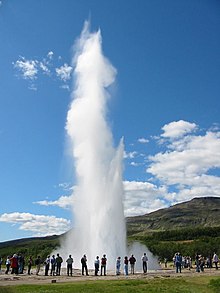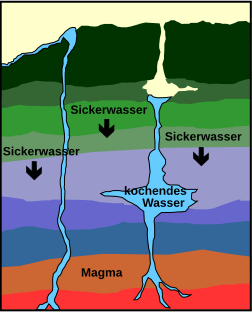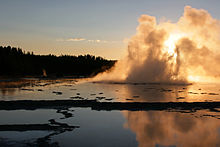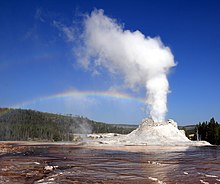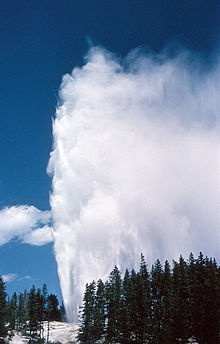geyser
A geyser [ ˈgaɪ̯ziːɐ̯ ], also Geiser , is a hot spring that emits its water as a fountain at regular or irregular intervals. Such an outbreak is known as an eruption. Geysers are named after the Great Geyser in Iceland .
etymology
The name Geysir / Geiser was formed from the Icelandic verb geysa "pour yourself out, splash out", which in turn is the frequency of the verb gjósa "gush, break out".
Similar phenomena
Other post-volcanic or thermal spring related phenomena:
- Mud volcano
- Fumarole
- Mofette
- Black smoker
- Solfatars
- Delayed boiling
- Coffee machine - technical analog
Occurrence
Geysers require a special combination of geological and climatic conditions that only exist over a large area in a few places. Geysers depend on three factors: a water supply in the form of an aquifer , a heat source (a plume or superplume) and at least one reservoir with a constriction to the associated pipe system.
There are six large geyser fields:
- Yellowstone National Park ( Wyoming ) (approx. 300 active geysers)
- Dolina Geiserow (the valley of geysers), Kronotsky National Biosphere Reserve Kamchatka ( Russia ) (approx. 200 active geysers; existence endangered by a landslide on June 3, 2007 with the formation of a reservoir)
- on the North Island of New Zealand (51 active geysers)
- El Tatio , Antofagasta ( Chile ) (38 active geysers, 46 in total in Chile)
- Haukadalur ( Iceland ) (26 active geysers across Iceland)
- Umnak Iceland ( Alaska ) (8 active geysers)
In the USA there are isolated geysers like in Nevada , California , Oregon and Alaska.
Papua New Guinea (16 active geysers), New Britain (16), Narage (1), Lihir and Ambitle Islands (9), Deidei and Iamelele Islands (12) and Indonesia with 8 active geysers have a notable number Sumatra , 4 on Java , 3 on Celebes and one active on Bacan Island .
Geysers also exist in Peru (10), People's Republic of China (10), Mexico (9), the Fiji Islands (5), Japan (4), Kenya (4), Ethiopia (2), Bolivia (2) and Myanmar ( 1).
Over 300 active geysers, about half of all existing worldwide, are located in Yellowstone National Park. In contrast, in Iceland, in the “land of geysers”, there are only two geysers worth mentioning: the Great Geyser and the Strokkur . The latter erupts irregularly every few minutes and sometimes up to three times in quick succession. The Great Geyser , which was first described in written sources after an earthquake towards the end of the 13th century, however, last erupted around 1916 with columns of water 70 to 80 m high. After two powerful earthquakes in 2000, however, as before after tremors with a delay of several months, there was a temporary increase in activity with irregular eruptions, which, however, were not comparable to previous heights and came to a complete standstill after a few years.
The number of active geysers should be viewed with caution, as geysers can become inactive very quickly and, in rare cases, inactive geysers are reactivated, for example by earthquakes. Several of the geysers listed above are also at risk of extinguishing or becoming inactive due to the planned use of geothermal energy. See: Geysers Destroyed by Humans . On the other hand, as in the case of the Fly Geyser , a faulty geothermal borehole can create a geyser made by human hands.
There were other, quite large geyser fields in Nevada until the 1980s: Beowawe and Steamboat Springs . However, by building geothermal power stations nearby, the existing heat was reduced and the water level sank so far that the geysers are no longer active.
properties
The first scientific model for the function of a geyser was explained by the German chemist Robert Wilhelm Bunsen in 1846 on the basis of an easily comprehensible experiment in which a model geyser was recreated on a smaller scale with a heated boiler as a reservoir and a tube as a channel and also "eruptive behavior." " shows.
Geysers occur in active volcanic areas. They have a canal in the form of a tube that opens into an underground water reservoir. There can also be several water reservoirs one behind the other. Typically, geysers are fed by the groundwater . The expelled water has a temperature between 90 ° C and just above the boiling point, the water in the reservoir can be overheated to much higher temperatures.
The eruption channel or narrowing in the eruption channel play an essential role in the eruptions of the geyser. If there is no constriction or if it is too wide, the water vapor can escape unhindered (steam source) or, if the steam cools down and condenses sufficiently, a hot source is created. The narrower the constriction, the more the thermal convection is prevented, and the pressure that the water column and sometimes the surrounding rock exerts on the heated water below depends on the height of the eruption canal. To illustrate this: the narrow point between the upper reservoir and the eruption canal of the Old Faithful is about ten centimeters in diameter. The bottleneck is about 7.5 m deep above the upper reservoir. Old Faithful was driven with a video camera to a depth of 16 m, so the conditions up to this depth are quite well known and the dynamics of the eruption of this geyser can be explained quite well.
The heat from a magma chamber heats the groundwater to over 100 ° C. Due to the pressure of the water column above, the water does not initially boil (increase in boiling point ). In the simplest case, the following happens in the event of an eruption: Only when the temperature in the reservoir has risen to well above the boiling point do individual steam bubbles rise through the narrow point in the channel and press part of the water column upwards. As a result, the pressure drops rapidly at the bottom and the superheated water suddenly turns into steam.
A mixture of boiling hot water vapor, cooler or condensed water and dissolved minerals and rock particles is thrown out. Over the years, fine crevices in the rock are widened into shafts by the hot water and, in the best case, lined with minerals (e.g. silicates) temporarily dissolved in the water and thus stabilized. If there is no effective constriction on the way to the surface, e.g. B. through a transition from a chamber (reservoir) to a pipe, the water emerges as a hot spring or steam source.
In essence, the Bunsen model is still considered to be correct today, even if Bunsen said that the conditions in nature itself are more complex and that instead of a vertical canal, there must be a “kneeling tube” at the highest underground part of which steam collects must until the pressure is sufficient to eject the water. Investigations on the Old Faithful with a temperature, pressure and camera probe in 1992 have shown that the model with the channel that is just ascending is sufficient ( Lit .: Scott Bryan, 1995) if there is sufficient constriction. The function of the constriction is sufficient to temporarily hold back vapor bubbles; it replaces the function of the elbow in the Bunsen model.
John Sargent Rinehart describes (1980) six geyser models:
- Model A: Ideally, an underground reservoir (several in a row are possible in practice) is connected to a long eruption canal, which ends above ground in a non-submerged cone. This model is also described by other sources as a nozzle-shaped (cone type) geyser. Type of eruption: Fairly regular intervals, long eruptions, high column of eruptions as water and steam jets. A typical representative of this model is the Old Faithful geyser in Yellowstone National Park.
- Model B: Deep, narrow eruption canal without a large underground chamber, the mouth of the canal is almost flat. Type of eruption: short violent eruptions. A typical representative of this model is the Round Geyser, Yellowstone National Park .
- Model C: Similar to model A, but not a high cone opening above the water level as the mouth of the eruption channel, but a nozzle just below the water surface of a pond. Type of eruption similar to model A, but not an undisturbed jet of water, but rather a torrent of water thrown up.
- Model D: Similar to model C, but a more complex system of several side chambers flows into the eruption canal, which empty one after the other. Type of eruption: series of eruptions with irregular short pauses, groups of eruptions, gush of water.
- Model E: The eruption canal leads from a larger underground chamber into a pond. Eruption type: Long, fairly regular eruptions that are not very violent, low eruption column in the form of a gush of water, no water jet.
- Model F: Deep, long eruption channel that opens into a pond. Eruption behavior like model E.
The following factors influence the operation of geysers:
- Seasons and amounts of precipitation (more or less intense), as precipitation in the sealed system, which requires a geyser, takes a very long time to reach the geyser aquifer (this can be determined from the ratio of the isotopes of hydrogen in the ejected water) ;
- Air pressure (crucial), as the boiling point of the water is directly dependent on the air pressure;
- Tidal forces (crucial), high tidal forces widen the crevices that supply the geyser with groundwater,
- Earthquake activity (varies from geyser to geyser and in some cases not directly dependent on the distance to the epicenter), but earthquakes cannot yet be predicted based on the activity of geysers.
Geysers can usually be distinguished from thermal springs even on the outside without observing the eruption activity.
- Dark-colored bacterial lawns usually only occur in the source pots of hot springs. The water in the eruption canals and ponds of geysers is too hot to permit these mats of dark thermophilic bacteria. Experience shows that the following rule applies: the hotter the water, the lighter the deposits of thermophilic bacteria.
- Hot springs often have sharp edges made of sinter that is deposited at the different water levels of the spring. Sinter deposits on geysers are more bulbous than sharp-edged.
- Sinter beans, sinter eggs, and tuber-shaped sinter indicate a geyser. These formations form with regular splashes and gushes of mineralized water.
Types of geysers
In relation to the periodicity of the eruptions, there are more or less regularly erupting and irregular erupting geysers. There are geysers where strong and weak eruptions can be distinguished. It cannot be proven that strong eruptions are the more irregular ones. The Steamboat Geyser in Yellowstone National Park has very irregular strong eruptions, the Castle Geyser is one of the geysers with the most regular interval, as long as it does not erupt in weak eruptions. Further differentiation options are described in the section Definition of Terms.
Photo sequence of an erupting geyser
- Eruption of the Strokkur
Geysers in New Zealand
Most of New Zealand's geysers have been destroyed by natural influences or human intervention since 1886.
- The Rotomahana geyser field was lost when the Mount Tarawera volcano erupted in 1886.
- Two thirds of the geysers in the Orakei Korako geyser field were flooded when the Ohakuri Dam was built in 1961.
- The Taupo Spa geyser field was lost when the Waikato River was diverted in the 1950s.
- The Wairakei geyser field no longer exists since a geothermal power plant was built nearby.
- The largest geyser to date, the Waimangu Gysir, became extinct due to natural causes; it only existed from 1900 to 1904.
The largest remaining geyser field in New Zealand today is Whakarewarewa near Rotorua .
Famous geysers
- Beehive Geyser (Yellowstone National Park, average interval in the measurement period 2003 approx. 18 hours irregularly, 45–55 m high fountain-like eruption column, four to five minutes duration, jet-like)
- Castle Geyser (Yellowstone National Park, mean interval 2003 outside the times with small eruptions about twelve hours 45 minutes IBE (interval between eruptions, see section Interval below) predictable, 20 to 30 m high eruption column, large eruption: 20 minutes water phase, 40 minutes vapor phase; jet-like)
- Giant geyser (Yellowstone National Park, interval very irregular and at times extremely long, duration of the eruption up to over an hour, 50-83 m high eruption column, jet-like, about two meters in diameter)
- Giantess Geyser (Yellowstone National Park, very irregular and at times extremely long (several months), 30-60 m high eruption column, water eruptions: eruptions five to ten minutes water phase followed by a 30 to 60 minute break, steam eruptions: steam phase up to six hours, like a fountain )
- Grand Geysir (Yellowstone National Park, mean interval of 9:50 hours IBE in the 2003 measurement period, not as regular as Old Faithful, 50-60 m high eruption column, ten to twelve minutes duration, often erupts several times in quick succession, up to eruptions nine minutes is usually followed by a second very spectacular breakout to full throwing height, like a fountain)
- Great Fountain Geyser (Yellowstone National Park, approx. 30–50 m high eruption column, interval twelve ± two hours, about ten percent of the eruptions as a particularly powerful eruption, spits with many pauses (up to five minutes) for about 1.5 Hours)
- Large geyser (Iceland, every 24 to 30 hours, ten meter high eruption column) Active again after a long period of inactivity since an earthquake in June 2000.
- Grotto geyser (Yellowstone National Park, interval irregular but predictable, ten to 13 m high eruption column, one to twelve, rarely more than 26 hours duration, like a fountain)
- Old Faithful Geyser (Yellowstone National Park, interval approx. 91 minutes IBE predictable, in 2003 a minimum of 45 minutes, a maximum of 124 minutes, 30-55 m high eruption column, two to five minutes duration, jet-like)
- Strokkur Geyser (Iceland, interval about ten minutes, 20–30 m high eruption column, short violent eruption)
Geysers in Seal
Karl May describes the geysers, sinter terraces and mud pots in Yellowstone National Park in his American story The Son of the Bear Hunter (other title: Among vultures - Part 1 ) in the chapter on Am P'a-wakon, lovingly , if not correctly in detail -tonka .
The end of a geyser
Why a geyser becomes inactive or goes out

Due to the permanent eruptions, the vent (eruption channel) enlarges over time and the geyser becomes a hot spring. Man-made artificial geysers are usually very stable in this regard, as the borehole is usually cased.
Earthquakes in the vicinity of a geyser can lead to a significant change in its eruption behavior. Not only can it wake up again, it can also become inactive or extinguish.
Building geothermal power plants near geysers mostly results in the geysers no longer erupting as the water table and the temperature of the water that feeds the geyser decrease.
The addition of detergents such as washing-up liquid or soft soap to the thermal water to provoke an outbreak also has a detrimental effect on the eruption activity in the long term. Where this practice was previously used to show tourists an outbreak, it is now mostly prohibited by law (example: Great Geyser , Iceland).
Vandalism also often leads to the end of the eruption activity of a geyser. If stones or objects are thrown into the chimney, the eruption can stop. Usually the eruption channel is blocked, the pressure of the eruption is insufficient to eject the foreign body and the geyser becomes a hot spring.
The most spectacular end to a geyser is when the surrounding rock cannot withstand the vapor pressure. This leads to the explosion of the geyser, i.e. the destruction of the uppermost part of the discharge chute. (Example: Porkchop Geyser in the Norris Geyser Basin , Yellowstone National Park exploded on September 5, 1989). If this hydrodynamic change does not stop the eruption oscillation, the outlet opening is destroyed in any case.
Geysers destroyed by humans
Geysers are very sensitive natural phenomena. Numerous geysers and geyser fields were mostly irretrievably destroyed by human activity.
The Ebony Geyser in the Norris Geyser Basin (Yellowstone National Park) was destroyed in 1950 by stones, blocks of wood and rubble being thrown into it. The Minute Geyser in the same region suffered the same fate. The pressure created a different canal, but the height of the eruption shrank to five percent of its original size.
The construction of geothermal systems brought the Beowawe Geyser , Spitfire Geyser , Teakettle Geyser , Pincushion Geyser and about 23 other geysers to the Beowawe Geyser field in Nevada to dry up around 1950. The remaining geysers in this field dried up in 1987 .
Also in Nevada, many geysers in the Steamboat Springs geyser field were destroyed by the construction of a geothermal power plant.
Numerous geysers on Iceland and New Zealand have also fallen victim to the construction of such power plants.
Definitions of terms
In connection with geysers, terms are often used that are translated from the English language.
Active geyser
A geyser is considered active if it has had an eruption within the last two years. This definition is an arbitrary agreement and is used for systematics.
Jet-like geyser (English: "Cone Type Geyser", translated: "Cone Geyser")
Jet-like geysers have a narrow jet of water and steam. You have no or only a very small pond that hardly affects the water jet. The mouth of the eruption channel does not necessarily have to be on a sinter cone, but the ejected water must not collect in deeper basins above the eruption channel. Corresponds to Rinehart Model A or B. Example: Old Faithful.
Inactive geyser (English: "dormant geyser")
A geyser is considered inactive if it has not exhibited eruptive behavior within the last two years. This definition is an arbitrary agreement and is used for systematics. An inactive geyser can definitely become active again (Giant Geyser, Yellowstone National Park; Great Geyser, Iceland).
interval
There are two definitions for this term:
- The length of time between the start of one eruption and the start of the next. The abbreviation from the English is IBE : Interval Between Eruptions.
- The length of time from the end of one eruption to the beginning of the next.
The first definition is mainly used in connection with the geysers in Yellowstone National Park, the second in connection with geysers outside the Yellowstone National Park, for example those in New Zealand. The specification of the interval should always be explained in this regard.
Fountain Type Geyser
Fountain-like geysers are located in a pond and do not throw the water in a sharp jet, but in a gush. The eruption can be divided into several eruptions (the definition of the GOSA makes this a condition). To describe the course of an eruption, however, the distinction between “jet-like” and “fountain-like” is not sufficient. More complex models have to be used here. Corresponds to Rinehart Model D through F. Example of a fountain-like geyser: Grand Geyser .
Wrong geysers
The collective term "false geyser" does not represent a rating, but rather serves to distinguish it from naturally occurring geysers in the system. “Fake geysers” can be just as impressive as real geysers. In the English-speaking world, false geysers are called "misnamed geysers". It is controversial whether artificial geysers and cold water geysers created by drilling are natural monuments.
There are three types of false geysers: man-made "artificial geysers", "cold water geysers" and "continuously erupting geysers".
Artificial geyser

If geothermally heated caves or aquifers are drilled into geothermally active areas that have an adequate water supply, geysers can form under suitable conditions that behave like natural geysers. A well-known artificial geyser is, for example, the Old Faithful of California in Calistoga, Napa Valley (interval about 30 minutes, eruption duration three to four minutes, eruption height 20 to 33 meters). On the other hand, Soda Springs in Idaho uses a timer and valve to cheat.
For illustrative purposes, there are constructions consisting of a gas-heated water tank and a pipe section connected to it that protrudes vertically upwards and is open at the top. The relaxation event, which can only be achieved once, occurs spontaneously with continuous heating of the water supply when the boiling temperature, which is slightly increased due to the pressure of the water column in the pipe, is reached in the container.
In the case of the Cola Mentos fountain , however, the outgassing of carbon dioxide is triggered by added substances.
Cold water geyser (English: "Eruption Controlled Geyser")
In cold water geysers , the pressure with which the water is driven out of the eruption channel is not generated by water vapor, but by carbon dioxide dissolved in the water or escaping into caves and suddenly peeling out. As a rule, they are the result of drilling . Well-known cold water geysers in German-speaking countries are the Wallende Born (eruption height about 2 to 4 meters, interval about 35 minutes) and the Andernach geyser (with a height of up to 60 m, the highest cold water geyser in the world, interval about 2 hours). In Slovakia , the is Herlianský geyser at Herľany .
See also Lake Nyos , which became famous for a similar eruption.
Continuously erupting geyser ("Perpetual Spouter")
A continuously erupting geyser is not a geyser in the actual sense (a geyser is characterized by its eruptive behavior occurring at intervals), but a thermal spring that, like a geyser, constantly emits hot water or hot water and water vapor. Porkchop Geyser in Yellowstone National Park was such a "perpetual spouter" before its explosion. The Fly Geyser north of Gerlach in the state of Nevada , USA is also of artificial origin (a spring borehole was connected to a hydrothermal spring) and a perpetual spouter.
Geysers as a biotope
Geysers, which were previously thought to be sterile because of the heat, are populated by archaea and bacteria that can withstand water temperatures of over 100 degrees. See more at Hyperthermophiles .
Geyser records
The geyser with the highest eruptions on earth is the Steamboat Geyser in Yellowstone National Park. The highest height of the fountain that has ever been observed was 130 m. A large eruption is rare on the steamboat, but then it reaches heights of at least 30 feet.
The geyser with the highest eruptions in history was the Waimangu geyser in New Zealand with a fountain up to 460 m high. The geyser only existed from 1900 to 1904. It was buried by a landslide.
Grot Yubileinyi in the Dolina Geiserow valleyon the Kamchatka Peninsulathrows high and far. The fountain is ejected at an angle and reaches a height of approx. 33 m and a width of up to 76 m.
The most regular intervals have been measured in Yellowstone National Park over the past few years at the Riverside Geyser and when the Castle Geyser does not erupt in small eruptions, it even surpasses the Riverside Geyser in regularity.
On the Neptune moon Triton there are nitrogen geysers, which eject a mixture of liquid nitrogen and carried away rock dust up to a height of 8 km.
literature
- John Sargent Rinehart: Geysers and Geothermal Energy . Springer Verlag, Berlin 1980, ISBN 0-387-90489-1
- T. Scott Bryan: The Geysers of Yellowstone, Third Edition . University Press of Colorado, Colorado 1995, ISBN 0-87081-365-X
- Carl Schreier: A field guide to Yellowstone's geysers, hot springs and fumaroles . 2nd Edition. Homestead Pub, Moose WY 2003, ISBN 0-943972-09-4
Web links
German:
- Stromboli online - volcanoes on Swisseduc: Yellowstone Caldera (several pages about geysers, also film clips)
- on geothermal fields, especially on the Haukadalur and the Hegill area in Iceland ( Memento from December 5, 2004 in the Internet Archive )
- The hot springs in Haukadalur (Iceland)
- Helgi Torfason: The geology of the Icelandic geysers. ( Memento from January 6, 2009 in the Internet Archive )
- Marc Szeglat: Geysers and hot springs on Vulkane.net, Oberhausen
- Thomas Walter: Geysers: How are the famous water fountains created? In: Earth System Knowledge Platform (ESKP). Helmholtz Center Potsdam - German Research Center for Geosciences, accessed on May 20, 2019 .
English:
- The Geyser Observation and Study Association (GOSA)
- Geysers and the Earth's Plumbing Systems - in-depth explanation of geyser models
- Geyser Resources plus Yellowstone Resources. Johnston's Archives
- Geysers. Museum of Unnatural Mystery
- WyoJones' Geyser Site
- Illustrated report in Russian and English on the developments in the Dolina Geiserow on Kamchatka since June 3, 2007
Individual evidence
- ↑ Video: Beth Taylor in Inside Yellowstone: Hot Water Ecosystem .wmv format
- ↑ Video: Beth Taylor in Inside Yellowstone: How Do You Tell a Geyser from a Hot Spring? .wmv format
